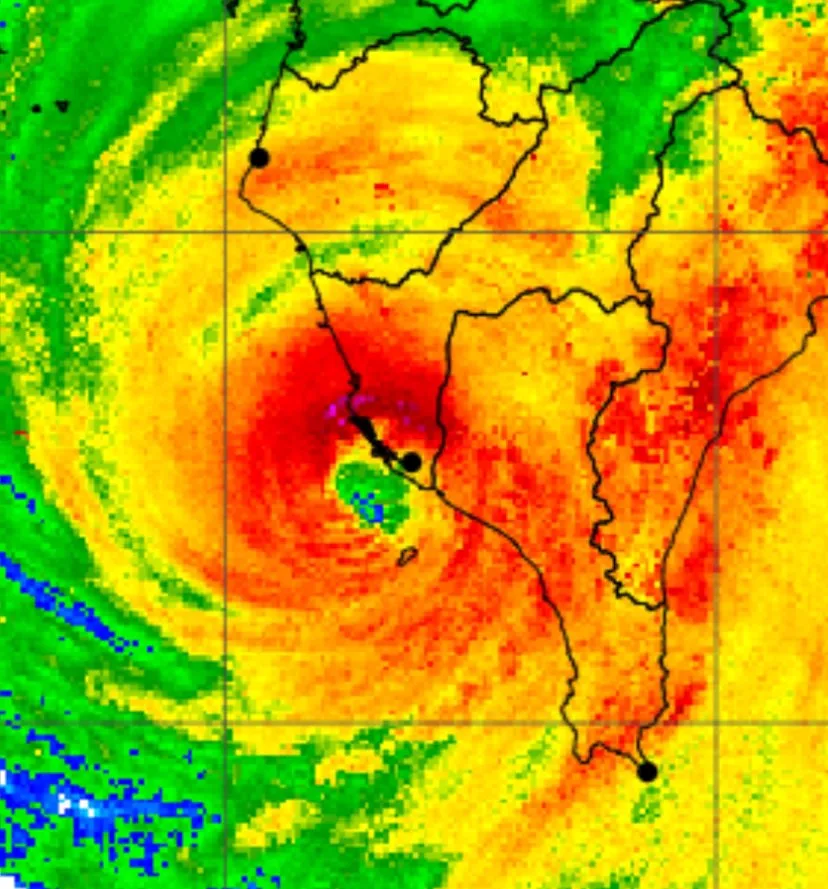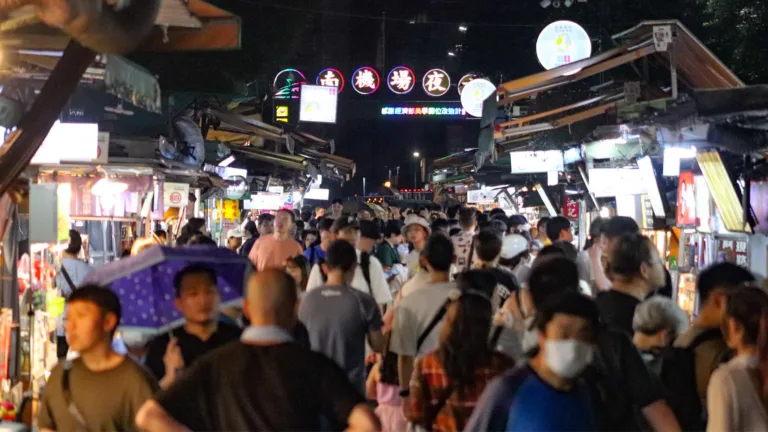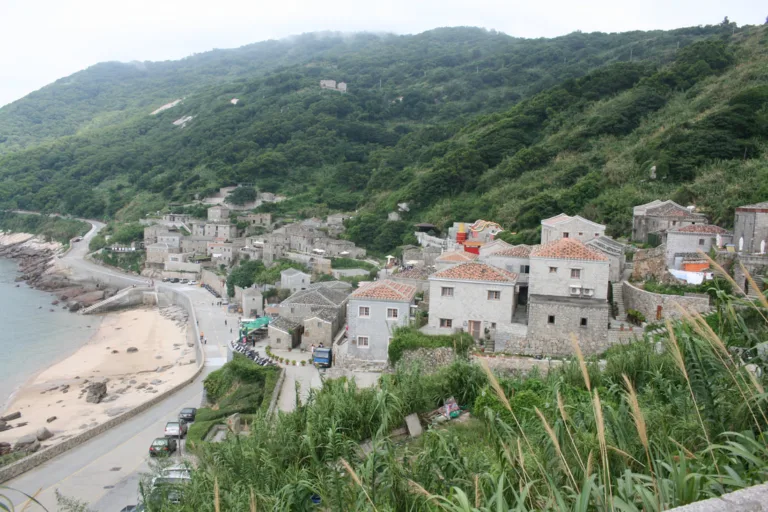Typhoon Krathon was the first Typhoon to make landfall in western Taiwan in over 38 years. So far it has caused at least two deaths in Taiwan, injured hundreds, dumped over a meter of rain in the mountains of Taitung, and caused work and school to close for four days in some areas. In this blog, I will detail some of the major events and overall situation in Taiwan during the Typhoon, as well as my own experience during this typhoon and past typhoons in Taiwan.
Basic Summary of the Typhoon 台風凱米大概的狀況
Typhoon Krathon became the second super typhoon to hit Kaohsiung in 47 years, following Typhoon Selma in 1977. It is also the first recorded tropical cyclone to make landfall in Kaohsiung in October. Notably, this is the first moderate typhoon to make landfall on Taiwan’s west coast in 38 years, since Typhoon Wayne in 1986. However, due to its slow movement and the intake of too much dry air, the typhoon weakened from a strong typhoon to a moderate typhoon, and eventually to a mild typhoon.
Typhoon Krathon was the 18th storm of the 2024 Pacific typhoon season and began forming as a tropical depression on September 26th, strengthened to a Category-4 Super Typhoon, and finally made landfall in Kaohsiung, Taiwan on October 3rd, 2024. Its highest winds reached 240 km/h. When it made landfall in Xiaogand District of Kaohsiung City, Taiwan, it was a category 1 Typhoon (winds between 74–95 mph, 119–153 km/h). As of the time of writing, the typhoon has caused over 2 fatalities in Taiwan and 400 injuries. A total of 176,506 households lost electricity. All domestic flights and hundreds of international flights in Taiwan were canceled for a time. Most mountain villages in Taiwan were evacuated. Flooding occurred in Kaohsiung, Keelung, and Taitung. As of the time of writing, Taimali District of Taitung received the most rain, with over 1500mm of rain (5 feet) over four days. Keelung also set a daily rain record of over 373 mm in one day.

The Typhoon was seen in forecast models over a week in advance, and as you can see the models kind of accurate.

Original track for Typhoon Krathon 2024 on September 27th.

The projected track changed again on the 28th.

The track then changed again the next day, getting slower and slower.

The Typhoon split the gap through the Bashi Channel between Taiwan and the Philippines, and strengthened offshore for a while to a super Typhoon.

However, as it lanked offshore, it kept on sucking up cooler water, losing energy, eventually striking Taiwan as a category 1.

Work and school were canceled for at least two days everywhere in Taiwan, and in the southern counties of Kaohsiung and Pingutng, four days of work and school were canceled.

The Typhoon finally made landfall on Thursday, October 3rd at about noon. It caused damage, destruction, and flooding in downtown Kaohsiung, before spewing rain over Pingtung and slowly fading into oblivion.

See above for the full track of the typhoon.

Overall the typhoon took a southwest turn from its original trajectory, making a loop around the Hengchun Peninsula before curving back up north and making landfall in Kaohsiung and dying.
As you can see, the models were way off pretty much the entire time. The models did not predict the slowdown or the trip west into the Bashi Channel. This is the main reason Taipei got two free Typhoon days off. Better safe than sorry.

The mountains of Taitung now hold the rainfall record during the past four days in the wake of Typhoon Krathon with over 1500 mm, which is 1.5 meters, or 5 feet, as tall as a person. This is less than Typhoon Morakot, which rained 2,600 mm over Pingtung. I thought that this Typhoon might be just as bad as Typhoon Morakot, but luckily there was much less damage and destruction.
The main reason for the massive rainfall is the southeasterly stream of wet air in the Typhoon’s tail that rammed into the southern Central Mountain Range.

There was also flooding in Keelung as mentioned above. I will never understand why the go-to tool for clearing up floodwater is a broom and dustpan.

The streets of Kaohsiung were also flooded.

Due to high winds, there was lots of destruction and devastation to trees, metal roofs, and cars in Kaohsiung.
Luckily relatively few people were injured.
My Experience in Taipei 我在台北的經驗
Ever since Super Typhoon Nepartak in 2016, which was the last major Typhoon to hit Taiwan, I have been fascinated with the epic destruction that these storms can bring. Typhoon Nepartak was the last Super Typhoon to make landfall in Taiwan. At the time I was living in Niaosong District of Kaohsiung. There was flooding, and we lost electricity for three days (and therefore water, because water could not be pumped to our building). Many streets were inundated with water, Chengqing Road was flooded, and nearly every tree in Chengqing Lake Park was stripped bare. Later I also visited Kenting and Xiaoliuqiu which had also received damage from Nepartak and Super Typhoon Meranti also. For photos of the damage at that time, check out our blogs to Chengqing Lake Park here, Kenting here, and Xiaoliuqiu here. I have always been awed and amazed by the immense destructive power that these storms create.
Other notable Typhoons since Nepartak include Nesat, Haikui, but because these did not become super Typhoons and did not cause major island-wide damage, they will not be covered in this blog. Another recent super Typhoon was Gaemi also in 2024, which hit Taipei much harder. You can read about that typhoon in our blog here.
Originally I had no plans for the week, and it was just going to be an ordinary, boring work week. Little did I know that I would get two Typhoon days off. I spent October 2nd and 3rd mostly at home watching TV. However my in-law’s fridge broke, and all the repairmen were on holiday, so we had to go and help throw out all the food in the fridge and clean it. Other than that, there was some wind and rain in Taipei but no flooding. For those of us in Taipei and much of northern Taiwan, it was two free days off, much like the snow days I used to long for as a kid in the US.

This is as bad as it got in Taipei. The rain was falling sideways. Very windy and rainy. The storm was not super strong but bad enough that you would not want to be outside.
Stories from those in Kaohsiung 其他高雄人的故事
I asked some of my followers in Kaohsiung how they were doing and what their stories were. Here are their responses:
- @WolfBlackrock Luckily no damage but trees were down around the neighborhood.
- @ajlyons Braved the worst of it earlier today to take my heavily pregnant wife to the hospital. Made it in the end!
- Maluz Ararao Little Hong Kong is flooding。 We are safe and sound.
- Christy Liu Road flooded near Kaohsiung Museum of Fine Arts
- Stefan Eckers no electricity
- Nursalim Rakesh Real I’m working (driving trucks)
- JLo Pez Bocauto We’re fine here in our district so far
- Jeff Barrons The park at Heart of Love River is a bit battered, the river is very high and flowing very fast right now.
- Kyle MacDonald My 711 is missing the entire front of the store
- Phyozar Aung After the typhoon, I went to 7 11 shop Near me, I saw many trees fell down along the road on my way.
- Shuaib Ahmad It was horrible but now it’s over
- Laura Huang Currently, the wind and rain in Fengshan District are subsiding, but there are many fallen trees and blown-away objects outside. If you need to go out, please be extra careful.
- Bryon Bowman 23rd-floor was swaying
- Jeff Barrons Bryon Bowman We had our building sway as well, it was a bit disconcerting.
- @OutRecording Part of our neighbor’s roof landed on our house. Another piece just fell down to our back area and broke some of our wood covering. Technically our chairs got destroyed. But they’ve needed to go for a while. They’ve gotten quite brittle. Wouldn’t take much to destroy them. Was easy work for the typhoon. The backside of this typhoon is hit hard. I had to clear the drain on the roof or it would be flowing down the stairs from the 4th floor. It took 5 trips and I’m soaked to the bone (and jammed my hand in the door a bit) but the water is cleared. On the plus side, I won’t need a shower today. I really need to drill a couple holes in that wall to catch the overflow.
Impact Around Taiwan 台灣其他地區的影響
Below are some videos and photos compiled around Taiwan to give you an idea of the Typhoon’s impact.
There are many other photos and videos of the destruction online if you search for Typhoon Krathon or 山陀兒.
Safety Precautions During a Typhoon 颱風天安全措施
- Secure loose outside objects
- If you live on the first floor of a flood-prone area, move as many valuables and important objects to higher floors as possible.
- Don’t ever rent an illegal rooftop structure. As seen in the videos above, the roof can get blown right off during a Typhoon. Get inside a concrete house.
- Park your car/scooter on high ground
- Avoid going outside for your safety
- Stay out of the mountains
- Stay away from the ocean
- Have enough dry food and water ready for three days (72 hours) in case water and electricity are cut off.
If you follow the above rules, most Typhoons in Taiwan will not be dangerous. Also, most buildings in Taiwan are built with reinforced concrete that can withstand even the strongest winds, so stay indoors and you will be fine.
Conclusion 結論
Nature is incredible. Ultimately nature is in control, but we can do our best to reduce risk and improve safety by following the precautions above.






